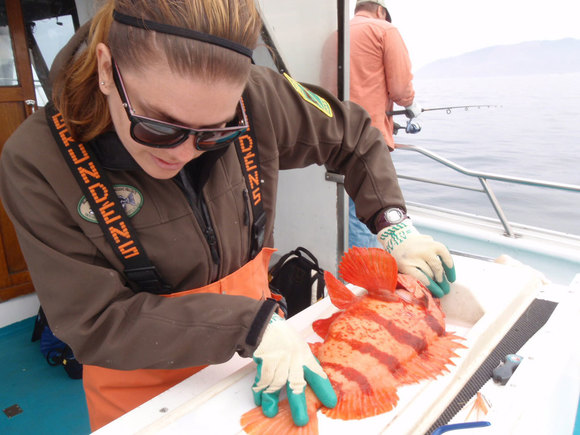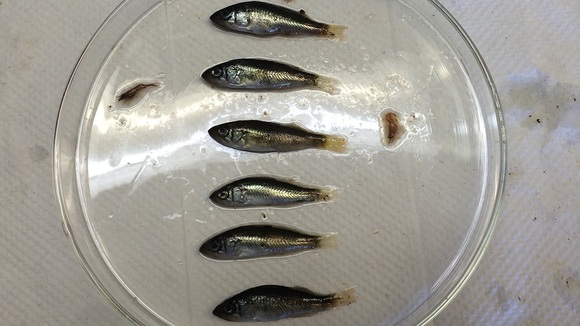IN THE KELP FOREST, THE TIGER ROCKFISH SLEEPS TONIGHT

Rockfish aren’t usually known for their good looks, but the tiger rockfish is out to change that. They are appropriately named after the thick dark bars that run down their bright orange body. Although not as voracious, they are (arguably) just as beautiful as the predatory cat they are named after. They can be found along the sea bottom in rock crevices, caves and around rocky outcroppings. Tiger rockfish have been recorded in Oregon’s Cascade Head, Redfish Rocks, Cape Falcon and Cape Perpetua marine reserves. Read more to learn about tiger rockfish.
TIS' THE SEASON FOR SEA STAR SURVEYS
The height of the summer brings the lowest tides of the year, which means it is time for intertidal sea star surveys. So why do we monitor sea stars in Oregon’s reserves? Two reasons. One, we’re working to help understand if and how sea stars are recovering after the massive Sea Star Wasting Disease outbreak that occurred along much of the West Coast of North America. Two, they are a keystone species which means they play a large role in defining rocky intertidal ecosystems. Without them the types of animals and seaweeds that dominate our rocky shores would look dramatically different. Read more to see results from our June surveys.
WEEKLY SMURFING SERIES

SMURFing is back for the summer 2017 ecological monitoring season, woohoo! Okay wait, what’s a SMURF again? We’re not talking about the little, blue, hat-wearing cartoons. SMURF stands for the “Standard Monitoring Unit for the Recruitment of Fishes” and is a sampling tool we use to collect information on juvenile fish. Tracking how many juveniles use nearshore habitats is helpful for understanding any changes we see in adult populations in the future.
SMURF research is conducted weekly and we're launching a series for you to learn more about what we're seeing when we go out sampling. Be sure to check out this summer series to learn about the research itself, the researchers and the work done in the marine reserves.
UPDATES FROM THE FIELD
 |
|
In July, we added two extra days of video lander survey work. Plus, SCUBA surveys were conducted at Otter Rock and Cape Falcon Marine Reserves and the associated comparison areas. |
 |
|
Conducted sea star wasting surveys at Otter Rock Marine Reserve and Cascade Head Marine Reserve. |
UPDATES FROM OUR COLLABORATORS
 |
|
Continuing through summer: Juvenile fish recruitment surveys (SMURFs) at Otter Rock and Redfish Rocks (by OSU, ODFW Marine Reserves Program, Oregon Coast Aquarium). |
 |
|
pH sensors were deployed at Redfish Rocks, Cape Perpetua, Otter Rock, Cascade Head, and Cape Falcon by PISCO scientists from OSU, with assistance from local community members. |
 |
|
Researchers from Humboldt State University came for a training on how to use the mini lander. They have constructed their own and will be using it this coming field season to monitor California’s North Coast Marine Protected Areas. |
HUMAN DIMENSIONS UPDATES
 |
|
One human dimensions study launched in July in Newport and Coos Bay. This study is an investigation of policy questions related to coastal resource management. This research is being conducted by OSU Cascades’ Dr. Kreg Lindburg’s and Katie Williams.
A second study by Portland State, will kick off in the next month and focuses on a snapshot of the Oregon commercial nearshore fleets (including: effort shift, aging of the fleet, etc.). The goal is to learn more about the fleet, which is important to management, policy and decision-making. This study is being led by Drs. Elise Granek and Max Nielsen-Pinkcus, along with graduate student Bryn Hudson.
|
See More Oregon Marine Reserves News
|